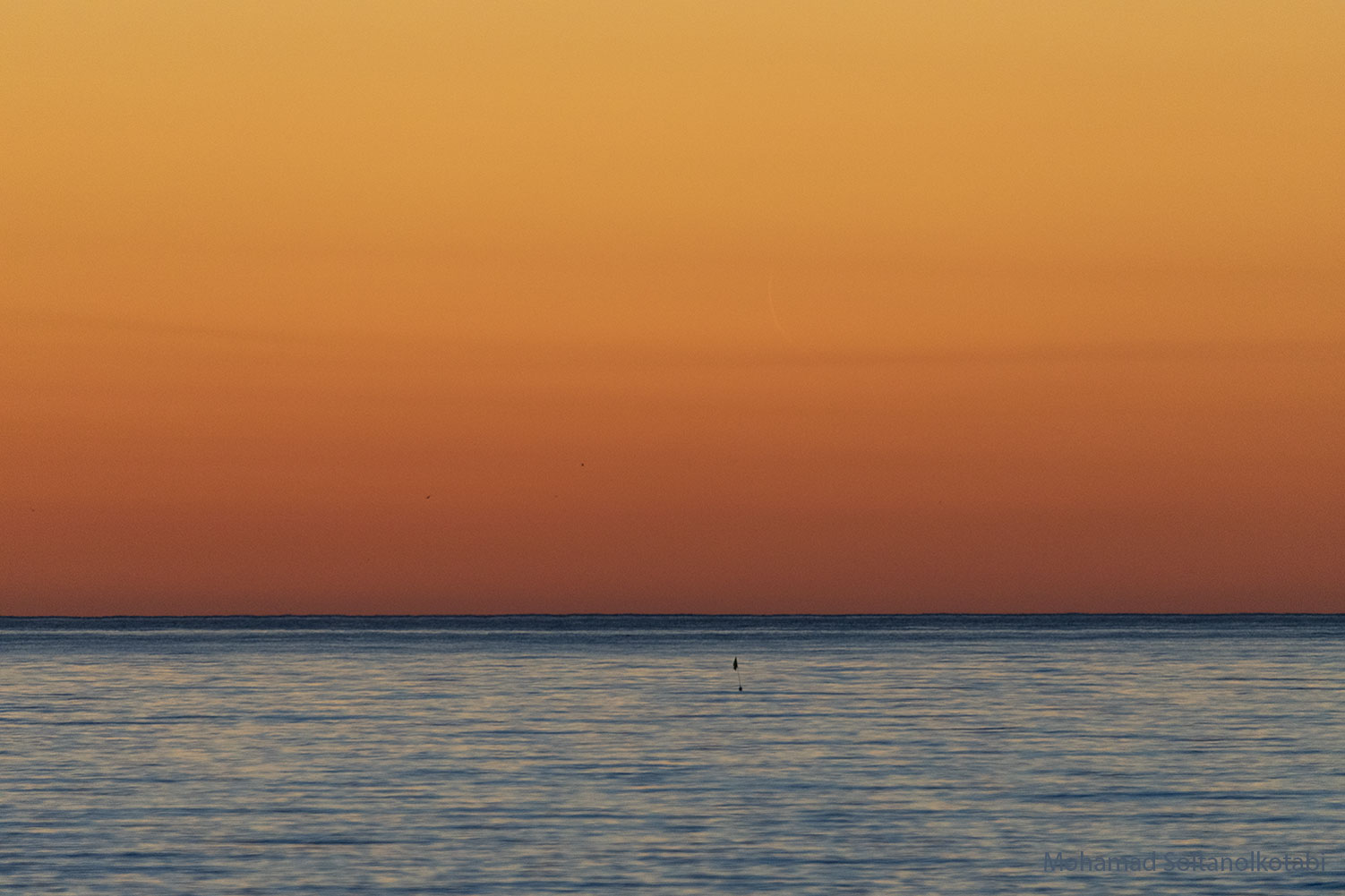25. July 2022
來揣新月

探索宇宙1!逐工會揀一幅無仝款 ê 影像抑是相片,𤆬你熟似咱這个迷人 ê 宇宙,閣有專業天文學者2為你解說3。
- 原始文章:Find the New Moon
- 影像來源 kah 版權:Mohamad Soltanolkotabi
- 台文翻譯:An-Li Tsai (NCU)
[漢羅] 來揣新月
毋知你敢有法度揣著月娘? 這款簡單 ê 任務通常是足困難達成–ê。 是講,月娘有一半時間攏 tī 地平線以上,月相 ùi 月眉到月圓攏有可能。 這張相片是 5 月底 ùi 西班牙 Sant Martí d’Empúries 鎮 翕–ê,是 tī 透早 ê 地中海 面頂。 你會 揣袂著 月娘 ê 其中一个原因,是因為這馬 ê 月相足倚 新月,去予 太陽 照著發光 ê 彼半爿,ùi 地球看較袂著。 另外一个原因,是因為月娘這馬 tī 地平線附近,月光愛迵過較長 ê 地球大氣層 才會到咱遮。 按呢本底就 較暗 ê 月眉,就閣較看袂著矣。 月眉 干焦會 tī 日頭附近出現,所以干焦會 tī 日出抑是日落才看會著。 月娘全部 ê 月相 走一輾,差不多愛 一個月。 這個月上薄 ê 月眉,就是 新月,閣 3 工就會出現矣。
[POJ] Lāi chhōe Sîn-goe̍h
M̄-chai lí kám ū-hoat-tō͘ chhōe-tio̍h goe̍h-niû? Chit-khoán kán-tan ê jīm-bū thong-siông sī chiok khùn-lân ta̍t-sêng–ê. Sī kóng, goe̍h-niû ū chi̍t-pòaⁿ sî-kan lóng tī tē-pêng-sòaⁿ í-siōng, goe̍h-siòng ùi goe̍h-bâi kàu goe̍h-îⁿ lóng ū khó-lêng. Chit-tiuⁿ siòng-phìⁿ sī 5 goe̍h-té ùi Se-pan-gâ Sant Martí d’Empúries tìn hip–ê, sī tī thàu-chá ê Tē-tiong-hái bīn-téng. Lí ē chhōe-bōe-tio̍h goe̍h-niû ê kî-tiong chi̍t-ê goân-in, sī in-ūi chit-má ê goe̍h-siòng chiok óa sin-goe̍h, khì hō͘ thài-iông chiò-tio̍h hoat-kng ê hit pòaⁿ-pêng, ùi Tē-kiû khah khòaⁿ-bōe-tio̍h. Lēng-gōa chi̍t-ê goân-in, sī in-ūi goe̍h-niû chit-má tī tē-pêng-sòaⁿ hū-kīn, goe̍h-kng ài thàng kòe khah tn̂g ê Tē-kiû tōa-khì-chân chiah ē kàu lán chiah. Án-ne pún-té to̍h khah àm ê goe̍h-bâi, to̍h koh-khah khòaⁿ-bōe-tio̍h–ah. Goe̍h-bâi kan-na ē tī ji̍t-thâu hū-kīn chhut-hiān, só͘-í kan-na ē tī ji̍t-chhut iah-sī ji̍t-lo̍h chiah khòaⁿ-ē-tio̍h. Goe̍h-niû choân-pō͘ ê goe̍h-siòng cháu chi̍t-liàn, chha-put-to ài chi̍t kò goe̍h. Chit kò goe̍h siōng po̍h ê goe̍h-bâi, to̍h-sī sin-goe̍h, koh 3 kang to̍h ē chhut-hiān–ah.
[KIP] Lāi tshuē Sîn-gue̍h
M̄-tsai lí kám ū-huat-tōo tshuē-tio̍h gue̍h-niû? Tsit-khuán kán-tan ê jīm-bū thong-siông sī tsiok khùn-lân ta̍t-sîng–ê. Sī kóng, gue̍h-niû ū tsi̍t-puànn sî-kan lóng tī tē-pîng-suànn í-siōng, gue̍h-siòng uì gue̍h-bâi kàu gue̍h-înn lóng ū khó-lîng. Tsit-tiunn siòng-phìnn sī 5 gue̍h-té uì Se-pan-gâ Sant Martí d’Empúries tìn hip–ê, sī tī thàu-tsá ê Tē-tiong-hái bīn-tíng. Lí ē tshuē-buē-tio̍h gue̍h-niû ê kî-tiong tsi̍t-ê guân-in, sī in-uī tsit-má ê gue̍h-siòng tsiok uá sin-gue̍h, khì hōo thài-iông tsiò-tio̍h huat-kng ê hit puànn-pîng, uì Tē-kiû khah khuànn-buē-tio̍h. Līng-guā tsi̍t-ê guân-in, sī in-uī gue̍h-niû tsit-má tī tē-pîng-suànn hū-kīn, gue̍h-kng ài thàng kuè khah tn̂g ê Tē-kiû tuā-khì-tsân tsiah ē kàu lán tsiah. Án-ne pún-té to̍h khah àm ê gue̍h-bâi, to̍h koh-khah khuànn-buē-tio̍h–ah. Gue̍h-bâi kan-na ē tī ji̍t-thâu hū-kīn tshut-hiān, sóo-í kan-na ē tī ji̍t-tshut iah-sī ji̍t-lo̍h tsiah khuànn-ē-tio̍h. Gue̍h-niû tsuân-pōo ê gue̍h-siòng tsáu tsi̍t-liàn, tsha-put-to ài tsi̍t kò gue̍h. Tsit kò gue̍h siōng po̍h ê gue̍h-bâi, to̍h-sī sin-gue̍h, koh 3 kang to̍h ē tshut-hiān–ah.
[English] Find the New Moon
Can you find the Moon? This usually simple task can be quite difficult. Even though the Moon is above your horizon half of the time, its phase can be anything from crescent to full. The featured image was taken in late May from Sant Martí d’Empúries, Spain, over the Mediterranean Sea in the early morning. One reason you can’t find this moon is because it is very near to its new phase, when very little of the half illuminated by the Sun is visible to the Earth. Another reason is because this moon is near the horizon and so seen through a long path of Earth’s atmosphere – a path which dims the already faint crescent. Any crescent moon is only visible near the direction the Sun, and so only locatable near sunrise of sunset. The Moon runs through all of its phases in a month (moon-th), and this month the thinnest sliver of a crescent – a new moon – will occur in three days.
詞彙學習(漢羅/POJ/KIP/華語/English)
- 【新月】sin-goe̍h/sin-gue̍h/新月/new moon
- 【月圓】goe̍h-îⁿ/gue̍h-înn/滿月/full moon
- 【月眉】goe̍h-bâi/gue̍h-bâi/眉月/crescent moon
- 【地平線】tē-pêng-sòaⁿ/tē-pîng-suànn/地平線/horizon